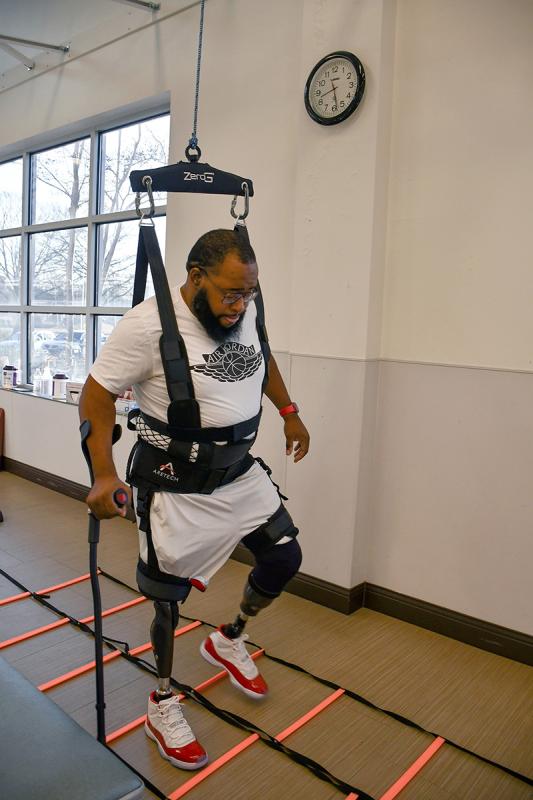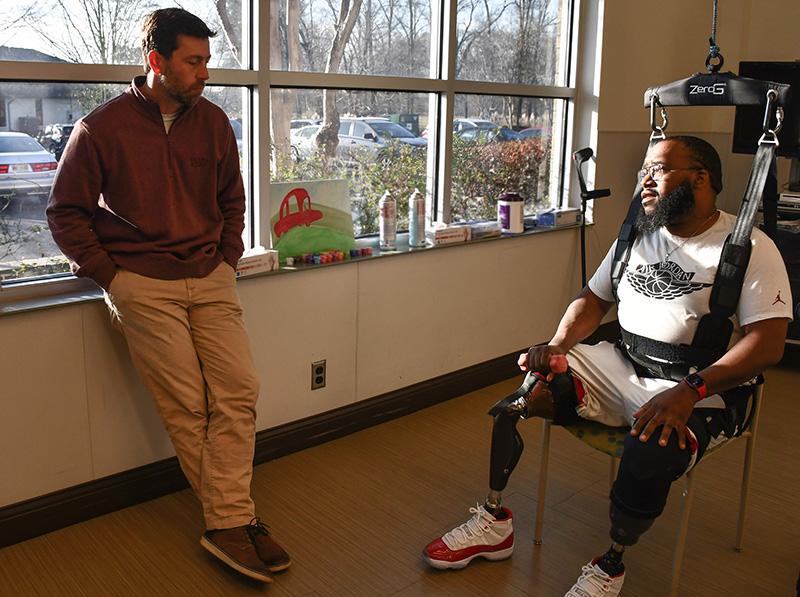The first time Chris Williams donned a prosthetic leg, “I walked out with it,’ he said.
The Byram resident had spent months fighting a diabetes-related foot infection, only to endure the disappointment of a below-the-knee amputation.
So he was more than ready to move on—whatever it took.
“My mentality was I’m going to beat this. I pushed the envelope, and I was back to normal pretty fast,” he said. “A lot of people didn’t know anything was wrong with me.”
But like many people with diabetes, Williams’ foot woes weren’t over. Five years after his first amputation, surgeons took off his right leg at mid-thigh.
Such scenarios are sadly familiar to Chris Wallace, director of Methodist Orthotics & Prosthetics, an eight-clinic division of Methodist Rehabilitation Center in Jackson.
“About 75 percent of the lower limb patients we deal with are the result of diabetes, peripheral vascular disease or other circulation problems,” Wallace said. “And following an initial amputation, the incidence of amputations on the opposite side are about 50 percent within five years.”
It’s no secret why Methodist O&P sees so many diabetes-related amputations. Mississippi is the only state in the U.S. where every county is in the Centers for Disease Control’s “diabetes belt.” The term describes areas where at least 11 percent of residents have been diagnosed with diabetes.
The disease often causes nerve damage and poor blood flow to the feet, a dynamic that raises the risk of foot ulcers and the ability to feel them. Wallace said he had one patient with feet so numb, he walked around never noticing a child’s toy in his shoe.
People of color are particularly vulnerable to diabetes complications. The American Diabetes Association says Black Americans like Williams have amputation rates up to four times higher than non-Hispanic white Americans. Hispanic communities are 50 percent more likely, and indigenous communities face a risk two times higher.
Yet a recent survey of people living with diabetes found 65 percent of participants believed they were not at risk for amputation. Just 1 in 4 understood the symptoms or conditions that can lead to amputations.
Now 47, Williams admits he was in denial when he was diagnosed with the disease at age 20.
At the time, he’d gone to the ER for back pain. “I thought I’d pulled a muscle,” he said. But after they did blood work, his caregivers came running. “They said: ‘Anyone tell you that you are diabetic? Your blood sugar is 400.’” (A fasting blood sugar level of 99 or lower is considered normal.)
Williams’ foot problems began in 2017, while he was working as an EKG technician at St. Dominic Hospital. The job required lots of walking, so he first blamed his painful feet on overuse. Turns out he had a pinhole size wound under the skin of his left sole. It caused an infection that led to his initial amputation.
“When I first found out, I was very distraught,” he said. “It’s hard someone telling you that you have to have a body part cut off. But they said once you get that removed, you can live a normal life— which is true.”
‘Once you get infection in your foot, it goes berserk’
Williams said his family and friends rallied to help him. And to make the most of his recovery, he chose to do post-surgery therapy at Methodist Rehab’s Jackson hospital. “Working in the medical field, you always heard it was the best place to go,” he said.
Next, Williams went to Methodist O&P’s Flowood clinic for a prosthesis. Taylor Hankins, a certified prosthetist, built and custom fit the leg, and Williams quickly adapted.
He started working as a home health aide and picked up traveling again. In the summer of 2022, he was in Cabo St. Lucas when another foot infection went from bad to life threatening.
Before the trip, Williams had fallen asleep during a pedicure. He’d only wanted his feet washed, but awoke to the pedicurist scraping his foot with a blade.
“She cut me, and I went to the store and got antibiotic cream. I thought it would be healed,” he said. “But it seems like once you get infection in your foot, it goes berserk.”
Even though Williams took antibiotics and used a wound vac while away, he got sicker by the day. “The whole time, I was sleeping and exhausted. I missed out on excursions, and I’d have to make myself eat,” he said. He headed to the ER as soon as he arrived home. Within days, he underwent an above-the-knee amputation, followed by a month in acute care.
After another stint in inpatient therapy at Methodist Rehab, Williams once again turned to Hankins for a new leg. To compensate for Williams’ missing knee, Hankins chose a prosthesis known as a C-Leg. It is equipped with a mini-computer that automatically adjusts the prosthetic knee joint to different terrain.
Still, Williams found it “a mental struggle” to get used to a new type of leg. And it was also a challenge physically.
“It takes a lot of energy, strength, balance and endurance to learn how to walk with a prosthetic knee,” Hankins said. “That’s why having physical therapists next door is so great.”
‘I’m just adjusting to life’
Methodist Outpatient Therapy is across the hall from Methodist O&P. And that’s where Williams has been working with physical therapist Karen Klein.
“She knows prosthetics, and that makes me want to be with her,” Williams said. “And she has been a go-getter. She will say, ‘Let’s try this’ or ‘Are you ready for this or that?’ She is on 100 all day long.”
Klein’s style is to mix a lot of trial and error with constant reassurance. “I’m a perfectionist, and she keeps me calm when I get frustrated with myself. She is really good at her job,” Williams said.
Klein said people like Williams are easy to treat because they work hard to get better. “But they are also among the hardest patients because you have to be prepared with ideas,” she said. “They come in and say: ‘What do you have for me today?’’’
Methodist Outpatient Therapy embraces new technology. And Williams has made great strides using its ZeroG Gait and Balance System. MRC is home to two of only three such systems in the state.
The equipment features a supportive harness attached to an overhead track system. It allows patients to practice walking, balance tasks, sit-to-stand maneuvers and even stairs without fear of falling. That was important to Williams, as he has the doubly difficult challenge of dealing with both above- and below-the-knee prostheses.
“Chris used it a lot in the beginning because he did not trust the new leg,” Klein said. All the while, she kept watch, looking for areas to address to make his walking as smooth as possible.
“The beauty of Chris is he has been a prosthetic user for a long time,” she said. “He’s also detail-oriented. So if something goes wrong, he catches it.”
So far, he’s gone from wheelchair to walker to two crutches to one. He’s also returned to working. He’s now a receptionist for New Jerusalem Church in Jackson.
“I’m just adjusting to life,” he said. “My goal right now is to get to the point I don’t need anything to walk with. I want to get back to normal life and seeing the world.”
Tips for Healthy Feet
- Check your feet every day. Look for cuts, redness, swelling, sores, blisters, corns, calluses or any other change to the skin or nails. Use a mirror if you can’t see the bottom of your feet, or ask a family member to help.
- Wash your feet every day in warm (not hot) water. Don’t soak your feet. Dry your feet completely and apply lotion to the top and bottom—but not between your toes, which could lead to infection.
- Never go barefoot. Always wear shoes and socks or slippers, even inside, to avoid injury. Check that there aren’t any pebbles or other objects in your shoes and that the lining is smooth.
- Wear shoes that fit well. For the best fit, try on new shoes at the end of the day when your feet tend to be largest. Break in your new shoes slowly—wear them for an hour or two a day at first until they’re completely comfortable. Always wear socks with your shoes.
- Trim your toenails straight across and gently smooth any rough edges with a nail file. Have your foot doctor (podiatrist) trim your toenails if you can’t see or reach your feet.
- Don’t remove corns or calluses yourself, and especially don’t use over-the-counter products to remove them—they could burn your feet.
- Get your feet checked at every health care visit. Also, visit your doctor every year (more often if you have nerve damage) for a complete exam, which will include checking for blood flow and feeling in your feet.
- Keep the blood flowing. Put your feet up when you’re sitting and wiggle your toes for a few minutes several times throughout the day.
- Choose feet-friendly activities like walking, riding a bike or swimming. Check with your doctor for which activities are best for you and any you should avoid.
Source: Centers for Disease Control and Prevention



